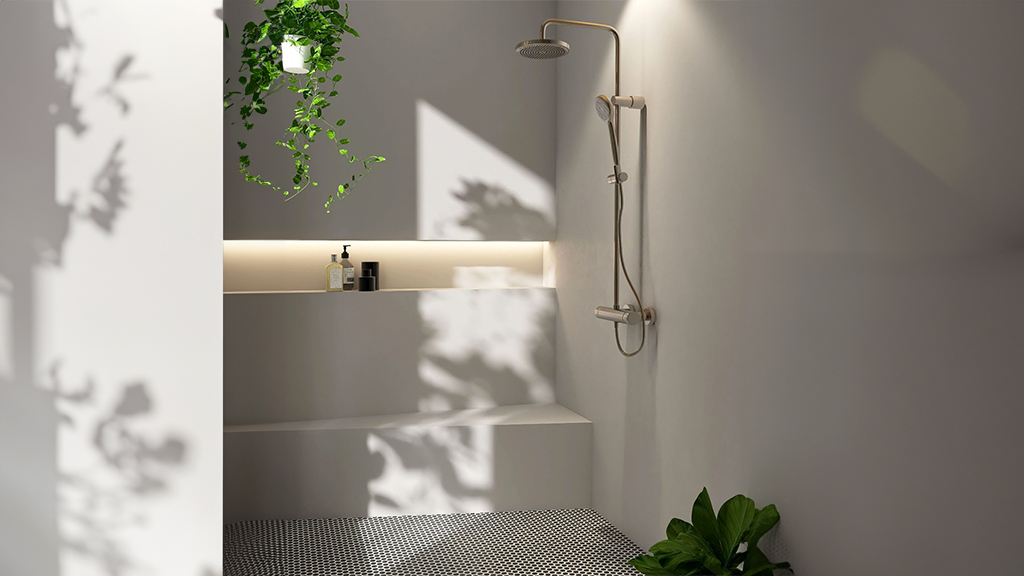Index
- Introduction: why to choose non-slip tiles for the shower
- Non-slip classifications for shower tiles.
- Ideal materials for non-slip tiles in shower
- Technical characteristics to consider
- Sizes and designs for non-slip shower tiles
- Solutions for every type of shower
- Installation and maintenance
- Conclusions and buying advice
Introduction: why to choose non-slip tiles for shower
The shower is one of the spaces most prone to slips and falls in the home. In an everyday environment such as the bathroom, safety must be a priority. Wet, slick or worn surfaces pose a real risk. For this reason, adopting slip-resistant shower tiles is not only a functional choice, but a real preventive measure.
Today there are many solutions that combine high performance with aesthetics, allowing you to design refined environments without sacrificing safety. This article aims to provide a comprehensive overview of materials, ratings, and selection criteria for slip-resistant shower tiles.

Anti-slip classifications for shower tiles
One of the key aspects to consider is the non-slip classification of tiles. There are several international standards:
System R (DIN 51130)
Measures grip on inclined surfaces with footwear. Classes range from R9 to R13. For household use, the most suitable are R10 and R11.
ABC classification (EN 16165)
Indicates resistance to slipping when barefoot, particularly useful for environments such as showering. Classes range from A (lowest) to C (highest).
PTV (Pendulum Test Value)
British system that measures grip in dry and wet conditions. A tile with R11 and B or C classification is an excellent choice for shower safety.
Ideal materials for non-slip tiles in shower
Each material has specific characteristics to be evaluated according to needs:
- Porcelain stoneware: high strength and aesthetic versatility; available in versions with non-slip textures.
- Glazed ceramic: suitable for residential settings; easy to clean, but it is essential that it has specific finishes.
- Mosaic: the presence of many joints naturally increases grip; ideal solution for small spaces and curved surfaces.
- Natural stone: aesthetically valuable, but requires non-slip and water-repellent treatments.
- Composite materials and resins: innovative solutions designed for specific performance and visual continuity.

A concrete example of technology applied to safety is Sicer’s NEXT EXPERIENCE SURFACES line, which was developed to offer highly textured, opaque, slip-resistant ceramic surfaces (up to R12) that are also ideal for high-humidity environments such as walk-in showers. The finish is designed to provide maximum grip, without compromising aesthetics or ease of cleaning.
Technical characteristics to be considered
Security is only one aspect. To make an informed choice, it is useful to evaluate:
- Impermeability and porosity: a tile with low absorbency reduces the risk of mold.
- Resistance to stains and cleaning products: important in an environment subject to daily use.
- Durability: the higher the mechanical strength, the longer the service life of the coating.
- Maintenance: smooth or treated surfaces are easier to clean.
- Antibacterial properties: now available in many collections, useful for improving overall hygiene.

Sizes and designs for non-slip shower tiles
Format and composition
Small format tiles or mosaics are often preferred for showers because the joints increase grip. Large formats are more suitable for modern bathrooms with flush floor plates.
Textures and finishes
Non-slip surfaces can come in sandblasted, textured, stone or concrete effect. Aesthetics today is no longer a compromise.
Colors and aesthetic harmony
Design does not have to give way to functionality: modern tiles offer a wide variety of colors, from neutral tones to bolder solutions.
Solutions for every type of shower

- Standard showers: most non-slip materials can be used.
- Flush showers: require greater adhesion and continuity of laying.
- Shower box: small space, precise installation, and high-strength materials.
- Open and accessible showers: solutions designed for the elderly or people with reduced mobility. Necessary to opt for certified materials.
Installation and maintenance
Laying stages
The surface must be perfectly leveled and waterproofed. The use of specific adhesives and grouts for wet environments is recommended.
Post-installation treatments
There are transparent protectors that increase the non-slip effect. Joints should be sealed to prevent seepage.
Ordinary cleaning
Use neutral detergents, avoiding waxes or oils that can impair adhesion.
Discover more articles on Sicer’s blog
Conclusions and purchase advice
Choosing non-slip shower tiles is a strategic choice for daily safety.
Correct selection of materials, supported by reliable technical certifications and expert installation, guarantees not only greater protection against household accidents, but also aesthetic and functional enhancement of the bathroom space. Thanks to advanced surfaces such as those developed by Sicer, it is now possible to achieve a perfect balance between safety, aesthetics and ease of maintenance, raising the overall quality level of one’s environment.







